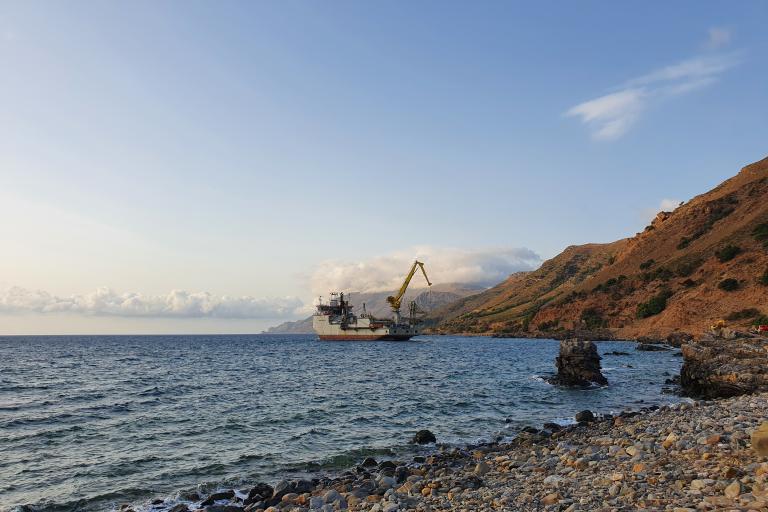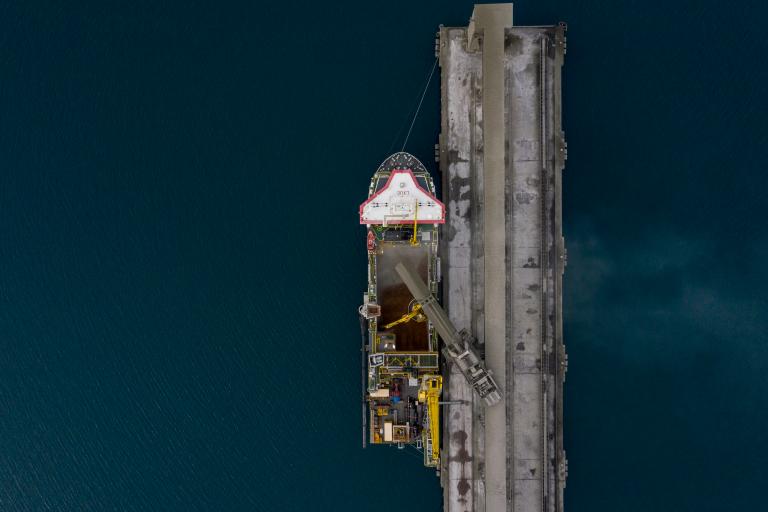Electricity network in Crete connected to the Greek mainland.
For several decades now, Greece has been keen to connect its largest island, Crete, to the mainland electricity network. Until recently, this was impossible. Cable production was not yet advanced enough to produce such an interconnector. The challenges were considerable : a length of 135 kilometres to be bridged and a depth of up to 1,000 metres with a seabed that was - to put it mildly - bitterly rough and challenging. The client sought and found a partner to finally realise this. A look behind the scenes of a challenging cable installation job for which Jan De Nul Group could pull out all the stops.
"Installing a cable on such a deep seabed with razor sharp rocks is a challenge
for which we like to find the ideal solution together with the client."
Tobias Bodere, Project Manager
Large water depths and ship deck conversion
The interconnector, which has to be installed over a distance of 135 kilometres, has a total cable weight of 12,000 tonnes. An ideal job for our cable layer Isaac Newton which has a unique carrying capacity thanks to its two big turntables.
Installing cables to a depth of 1000 m will, due to the weight of the cable, entail significant forces on the ship. At the deepest point, the tensions during installation run up to 75 tons, fifteen times higher than on the more common cable installation projects. In order to be able to cope with these extreme forces, we adapted the aft deck of the vessel. We mobilized a high capacity tensioner and winch, and also adapted the chute and a large part of the trackway.
“The exceptional installation depth entails huge forces, both on the vessel and the cable equipment. All necessary constructions and equipment have therefore been custom made.” Pieter Vanhulsel, Technical Superintendent
Customised cable protection applied manually
The rigidity of the interconnector does not allow to follow the seabed perfectly, with the consequent risk of vortex induced vibrations. Not being in full contact with the seabed allows the water to flow both above and below the cable. This can lead to pressure differentials and can generate vibrations of the cable with possible long-term fatigue damage. In addition, there was also the widely varying, rough seabed. Sharp rocks can cause the cable to bend sharply enough to damage it. In addition, a minimum bend radius must always be observed during the installation of a cable.
"A minimum bend radius, maximum tension, minimum tension, etc. When installing a submarine cable, we analyse the impact on the cable itself and on the ship to guarantee the integrity of the cable at all times." Bart Ledoux, Engineering
Together with the client, we looked for suppliers who could supply cable protection (or cable protection systems, in short “CPS”). This is installed around the cable in order to protect it from the abovementioned phenomena. Given the uniqueness of this project, tailor made CPS were installed. When designing the vessel and the CPS, the ease of the actual installation on the deck of the vessel was also taken into account. The CPS pieces were made as light as possible, the height of the work tables could be hydraulically adjusted to be able to work as ergonomically as possible, additional davits were placed, extra manpower was mobilized . A total of 5 different types of CPS were installed on the cable, which equals a total length of approx. 3.7 km. These were delivered to more than 40 containers. Not an everyday capacity for a cable-laying vessel. Fortunately, the Isaac Newton has a very large deck. The safety and efficiency of the CPS installation largely depends on the preparation. The different CPS types were pre-installed several times on a test cable in order to test feasibility and optimize efficiency.
"It was hard manual work for our people to install this much protective equipment, but everyone was happy they could contribute to this unique project and thanks to the effort and motivation of the entire team we were able to conclude this project successfully." Max Noordzij, Captain Isaac Newton

